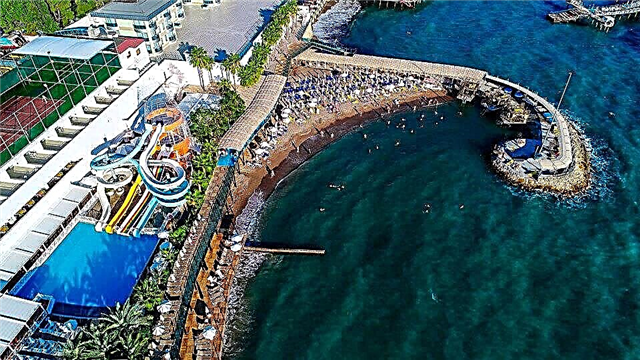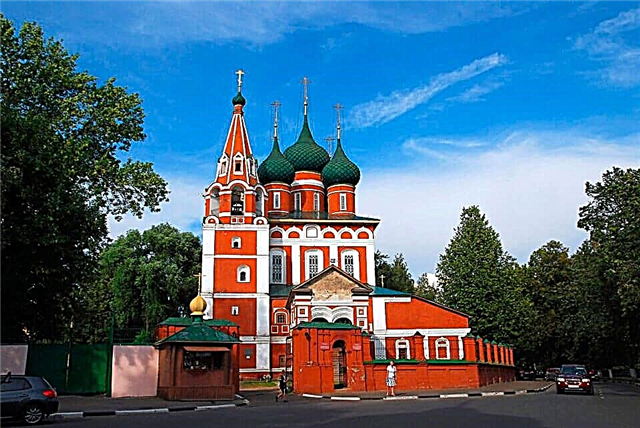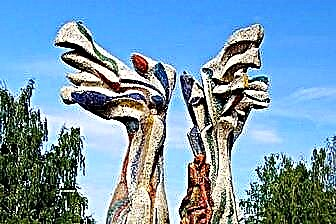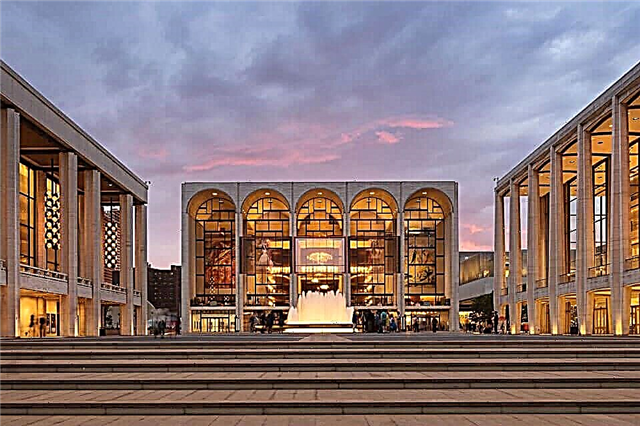Address: Russia, Nizhny Novgorod Region, Nizhny Novgorod, Privolzhskaya Sloboda, 108
Based: in 1328
Main attractions: Cathedral of the Ascension of the Lord (1632), Church of the Assumption of the Blessed Virgin Mary (1648), Church of Euthymius of Suzdal (1645), Church of Peter and Paul (1738), bell tower
Shrines: miraculous icon of the Mother of God of Orange
Coordinates: 56 ° 19'24.1 "N 44 ° 03'00.2" E
Content:
The monastery on the steep right bank of the Volga was founded more than 680 years ago and has seen a lot in its lifetime - princely feuds, raids of the Tatars, difficult times of Troubles, the greatness of the Russian sovereigns and decades of desolation. Its name - Voznesensky, he received from the first built temple. And they began to call the Pechersky monastery after the monastic caves on the Volga bank, from which this monastery began.

Pechersky Monastery from a bird's eye view
History of the Pechersky Monastery
Saint Dionysius of Suzdal is considered to be the founder of one of the oldest Christian monasteries on the Nizhny Novgorod land. He arrived in the city from the Kiev-Pechersky Monastery in the 1320s. From those distant times, very little historical information has survived, but it is believed that the new monastery was created with the blessing of Dionysius and appeared in 1328-1330.
The monastery began with several caves dug by monks in the steep limestone bank of the Volga. Rumors about Dionysius spread quickly, and new monks came to the small monastery. Soon there was not enough space in the caves; wooden cells and temples began to be erected on the coastal ledge.
Dionysius enjoyed great prestige among the believers. For the parishes of Nizhny Novgorod and Suzdal, this Christian preacher played the same role as Sergius of Radonezh in the lands of Muscovy. The disciples of Dionysius, the monks Euthymius and Macarius, who were numbered among the saints by the Church for their ascetic deeds, began to enjoy no less respect.
The Pechersk monastic brethren lived according to a strict charter. The monks did not have personal property, and all property belonging to the monastery was considered common. Everyone who was within the walls of the monastery, including its abbot, worked daily to feed himself, trying to follow the principles of hard work, mercy and non-covetousness. It was possible to leave the monastery only with the permission of the abbot.

General view of the Pechersky monastery from the side of the Pechersky congress street
The monastery, created from the caves, constantly strengthened and developed, despite the raids that temporarily deprived it of material values. In 1378 and 1379. The Tatar-Mongols burned the monastery to the ground, and practically nothing remained of the Pechersk monastery in 1550.
The princes or wealthy citizens of Nizhny Novgorod, who made rich contributions to the treasury of the Pechersk monastery, helped the monastery to recover. The monastery received not only money for new construction or renovation of a dilapidated economy. Whole villages, hunting grounds, arable land and apiaries were assigned to him. In the middle of the 15th century, the monastery received the right of duty-free trade and transportation of fish along the river. And by the end of the 16th century, six stone churches were built in the monastery. This speaks of the great wealth of the monastery, since at that time there were only three stone churches in the central part of Nizhny Novgorod.
In the summer of 1597, a great disaster struck the Pechersky Monastery. And the reason for it was neither enemies, but nature itself - a giant landslide destroyed almost all the monastery buildings. Partial ground movements that occurred a week before the landslide became for the abbot of the monastery a clear sign of impending disaster. Therefore, he took all the inhabitants to a safe place in advance, and also ordered that all the most valuable things be taken out of the monastery buildings - icons, church utensils and household equipment. In front of the amazed monks, a piece of the mountain descended to the river, completely destroying all the temples and cells.

The western gate of the monastery
After a natural disaster, the monastery had to be rebuilt. But they did it already on a leveled site up the river. Until the 40s of the 17th century, only wooden churches and outbuildings were erected here. Stone temples, towers and walls appeared in the monastery later. They made up an amazingly beautiful architectural ensemble, an excellent view of which opened both from the mountain and from the Volga.
The Pechersk monastery was famous for its charity. Many times the monastery allocated money and provisions for the Russian army. During the wars, refugees lived within its walls. In addition, the monks helped the wounded and the poor.
After the coming of the new government in 1917, the old monastery, like most of the Christian monasteries, faced desecration and desolation. A year after the revolution, the abbot of the monastery, Bishop Lawrence (Knyazev), was arrested and shot. The monastery sacristy was plundered, and the ancient bells, metal parts of the fence and crosses were given for melting.
Restoration work began here only in the 1970s. And the Church received the monastery territory in 1994. Since that time, the revival of the ancient Pechersk monastery began as a spiritual center and a place where the history of the Nizhny Novgorod diocese is kept.

View of the Church of Euthymius of Suzdal (right), Cathedral of the Ascension of the Lord (left)
Temples and buildings of the monastery
The central part of the monastery territory is occupied by the majestic Ascension Cathedral. Initially, there was a tent-roofed wooden temple here. By 1640, a stone cathedral with a refectory and a side-altar in honor of the Intercession of the Most Holy Theotokos was built in its place. The five-domed temple was erected on a high basement, and clay voices were arranged in the walls of the refectory for better acoustics. The roof of the cathedral was originally made of aspen wood for zakomary. But in the second half of the 18th century, the wooden roof was replaced with an iron one and a more practical four-slope shape was given to it.
A high three-tiered bell tower is attached to the cathedral - a rare example of preserved Russian belfries of pre-Petrine architecture. In 1701, by order of Tsar Peter I, 11 bells were removed from here, which were sent to be melted down to make cannons.
In the 17th century, in the place where this bell tower stands, the bulk soil partially slid down the slope, and the tall building tilted to the north. But the savvy Nizhny Novgorod masons found an unusual solution - in 1751 they moved the upper part of the bell tower strictly vertically, leaving the lower tiers unchanged. The fact that the bell tower has remained stable for more than two and a half centuries testifies to the correctness of the calculations and the skill of the builders.

General view of the buildings of the monastery
Next to the Ascension Cathedral there is a refectory church of the Assumption, which was erected at the end of the 40s of the 17th century. This one-domed temple, like the cathedral, has a high basement, where kitchens and bread were located in former times. To heat the church, they used the heat that was obtained from cooking, as well as from three tiled stoves. Therefore, the premises were adapted for holding church services in the cold season.
One of the architectural adornments of the monastery ensemble is the gateway church dedicated to the Monk Euthymius of Suzdal, a disciple of Saint Dionysius. It was erected in 1645, and Nizhny Novgorod architects used the Archangel Cathedral in the city Kremlin as a model for this beautiful temple. Despite the obvious similarities, the monastery temple has some characteristic features. Its altar is not semicircular, but rectangular, and, moreover, this church has no bell tower and narthex.
The entire territory of the monastery is surrounded by a white stone wall, in which there are the picturesque Holy Gates and several towers.In addition, the monastery houses two-story fraternal and abbot buildings, Bishops' chambers with a house church dedicated to Sergius of Radonezh, as well as a small Peter and Paul Church. The most beautiful monastery ensemble is today recognized as an architectural monument of federal significance.

Cathedral of the Ascension of the Lord with a bell tower
Church and Archaeological Museum
On the territory of the Orthodox monastery there is a rich museum collection telling about the pages of the history of the Nizhny Novgorod diocese. This museum is located on two floors of a tower building, not far from the Ascension Cathedral.
Visitors can see interesting archaeological finds made on the territory of the monastery, bishops' letters, old photographs and archival documents of the 16th-18th centuries. The museum displays rare handwritten and printed books, clergy clothes, awards, church utensils and icons. In addition, the museum exhibits include items from the monastery necropolis, commemorative cast-iron plates, colored ceramic tiles and a 17th century forged metal cross. On the ground floor of the museum, there is a photo studio where you can take a memorable photo in antique-styled interiors.
Current state and visiting regime
Today, the Ascension Pechersk Monastery is an active male monastery, the territory of which is open to pilgrims and tourists from 7.30 to 18.30. The images of the Mother of God - Oranskaya, Pecherskaya and Fedorovskaya - are considered especially revered monastic shrines. In addition, believers come here to pray near the icons of the saints - the great martyr Panteleimon and Dionysius of Suzdal, the arks with the relics of St. Matrona of Moscow and the Monk Simeon of Verkhoturye, as well as near the shrine with the relics of Christian saints.

Church of the Assumption of the Blessed Virgin Mary
How to get to the monastery
The monastery is located 3 km from the Nizhny Novgorod Kremlin, near the Grebnoy Canal Embankment, at the address - Privolzhskaya Sloboda, 108. You can drive up to it by buses and fixed-route taxis (bus stops Sennaya Bus Station or Donetsk Street).











